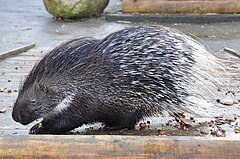Jeżozwierzowate
| Hystricidae | |||||
| G. Fischer, 1817[1] | |||||
 Przedstawiciel rodziny – jeżozwierz afrykański (Hystrix cristata) | |||||
| Systematyka | |||||
| Domena | |||||
|---|---|---|---|---|---|
| Królestwo | |||||
| Typ | |||||
| Podtyp | |||||
| Nadgromada | |||||
| Gromada | |||||
| Podgromada | |||||
| Infragromada | |||||
| Rząd | |||||
| Podrząd | |||||
| Infrarząd | |||||
| (bez rangi) | incertae sedis | ||||
| Rodzina |
jeżozwierzowate | ||||
| Typ nomenklatoryczny | |||||
|
Hystrix Linnaeus, 1758 | |||||
| |||||
| Rodzaje | |||||
| |||||
Jeżozwierzowate[21] jeżozwierze[22] (Hystricidae) – rodzina ssaków z infrarzędu jeżozwierzokształtnych (Hystricognathi) w obrębie rzędu gryzoni (Rodentia). Największym z gatunków jeżozwierzy jest żyjący także w południowej Europie jeżozwierz afrykański (Hystrix cristata). Niekiedy błędnie nazwą „jeżozwierz” określa się żyjące w Ameryce ursony.
Zasięg występowania[edytuj | edytuj kod]
Od południa Europy przez całą Afrykę i Indie do Borneo[23][24][25].
Charakterystyka[edytuj | edytuj kod]
Stronę grzbietową ciała tych zwierząt pokrywają kolce (będące przekształconymi włosami). Jeżozwierzowate są roślinożerne.
Systematyka[edytuj | edytuj kod]
Do rodziny jeżozwierzowatych należą następujące występujące współcześnie rodzaje[26][24][21]:
- Trichys Günther, 1877 – skąpokolec – jedynym przedstawicielem jest Trichys fasciculata (G. Shaw, 1801) – skąpokolec malajski
- Atherurus F. Cuvier, 1829 – jeżatka
- Hystrix Linnaeus, 1758 – jeżozwierz
Opisano również rodzaje wymarłe:
- Sivacanthion Colbert, 1933[27] – jedynym przedstawicielem był Sivacanthion complicatus Colbert, 1933
- Xenohystrix Greenwood, 1955[28] – jedynym przedstawicielem był Xenohystrix crassidens Greenwood, 1955
Uwagi[edytuj | edytuj kod]
Przypisy[edytuj | edytuj kod]
- ↑ a b J.G. Fisher von Waldheim. De systemate Mammalium. „Mémoires de la Société impériale des naturalistes de Moscou”. 5, s. 372, 1817. (łac.).
- ↑ C.S. Rafinesque: Analyse de la nature, or, Tableau de l’univers et des corps organisés. Palerme: Aux dépens de l’auteur, 1815, s. 57. (fr.).
- ↑ J.G. Fisher von Waldheim. De systemate Mammalium. „Mémoires de la Société impériale des naturalistes de Moscou”. 5, s. 372, 1817. (łac.).
- ↑ J.E. Gray. On the Natural Arrangment of Vertebrose Animals. „The London Medical Repository”. 15, s. 304, 1821. (ang.).
- ↑ G.T. Burnett. Illustrations of the Quadrupeda, or Quadrupeds, being the arrangement of the true four-footed Beasts indicated in outline. „Quarterly Journal of Science, Literature and the Arts”. July to December, 1829, s. 350, 1829. (ang.).
- ↑ Ch.L. Bonaparte: Saggio di una distribuzione metodica degli animali vertebrati. Roma: Antonio Boulzaler, 1831, s. 21. (wł.).
- ↑ Ch.L. Bonaparte: Synopsis Vertebratorum Systematis. 1837, s. 9. (fr.).
- ↑ R.-P. Lesson: Nouveau Tableau du Règne Animal: Mammifères. Paris: Arthus Bertrand, 1842, s. 96. (fr.).
- ↑ Ch.G.A. Giebel: Die säugethiere in zoologischer, anatomischer und palæontologischer beziehung umfassend dargestellt. Leizpzig: A. Abel, 1855, s. 471. (niem.).
- ↑ S.F. Baird: Mammals. W: United States. War Department: Reports of explorations and surveys, to ascertain the most practicable and economical route for a railroad from the Mississippi River to the Pacific Ocean. Made under the direction of the secretary of war, in 1853-1857. T. 8. Cz. 1: General report upon the zoology of the several Pacific Railroad routes. Washington: A.O.P. Nicholson, Printer, 1857, s. 236, 566. (ang.).
- ↑ E. Blyth: Catalogue of the Mammalia in the Museum Asiatic Society. Calcutta: Savielle & Cranenburgh, 1863, s. 128. (ang.).
- ↑ E. Haeckel: Generelle morphologie der organismen. Allgemeine grundzüge der organischen formen-wissenschaft, mechanisch begründet durch die von Charles Darwin reformirte descendenztheorie. Cz. 2. Berlin: G. Reimer, 1866, s. clx. (niem.).
- ↑ A. Murray: The Geographical Distribution of Mammals. London: Day and Son, 1866, s. xiv, 351. (ang.).
- ↑ J.V. Carus: Handbuch der Zoologie. Cz. 1: Wirbelthiere, Mollusken und Molluscoiden. Leipzig: Wilhelm Engelmann, 1868, s. 109. (niem.).
- ↑ T.N. Gill. Arrangement of the Families of Mammals; with Analytical Tables. „Smithsonian Miscellaneous collections”. 11, s. 22, 1872. (ang.).
- ↑ O. Thomas. On the Genera of Rodents: an Attempt to bring up to Date the current Arrangement of the Order. „Proceedings of the Zoological Society of London”. 1896, s. 1025, 1896. (ang.).
- ↑ F.E. Schulze. Mammalia Europaea. „Helios - Abhandlungen und Mitteilungen aus dem Gesamtgebiete der Naturwissenschaften”. 14, s. 82, 1897. (niem.).
- ↑ M.W. Lyon. Notes on the porcupines of the Malay Peninsula and Archipelago. „Proceedings of the United States National Museum”. 32, s. 576, 584, 1907. (ang.).
- ↑ G.S. Miller & J.W. Gidley. Synopsis of the supergeneric groups of rodents. „Journal of the Academy of Natural Sciences of Philadelphia”. 8, s. 444, 1918. (ang.).
- ↑ H.Н. Каландадзе & А.С. Раутиан: Система млекопитающих и историческая зоогеография. W: Филогенетика млекопитающих. Москва: Издательство Московского университета, 1992, s. 92. (ros.).
- ↑ a b Nazwy polskie za: W. Cichocki, A. Ważna, J. Cichocki, E. Rajska-Jurgiel, A. Jasiński & W. Bogdanowicz: Polskie nazewnictwo ssaków świata. Warszawa: Muzeum i Instytut Zoologii PAN, 2015, s. 286. ISBN 978-83-88147-15-9. (pol. • ang.).
- ↑ Z. Kraczkiewicz: SSAKI. Wrocław: Polskie Towarzystwo Zoologiczne - Komisja Nazewnictwa Zwierząt Kręgowych, 1968, s. 81, seria: Polskie nazewnictwo zoologiczne.
- ↑ Hystricidae. Animal Diversity Web. [dostęp 2010-02-06]. (ang.).
- ↑ a b C.J. Burgin, D.E. Wilson, R.A. Mittermeier, A.B. Rylands, T.E. Lacher & W. Sechrest: Illustrated Checklist of the Mammals of the World. Cz. 1: Monotremata to Rodentia. Barcelona: Lynx Edicions, 2020, s. 542–544. ISBN 978-84-16728-34-3. (ang.).
- ↑ D.E. Wilson & D.M. Reeder (red. red.): Family Hystricidae. [w:] Mammal Species of the World. A Taxonomic and Geographic Reference (Wyd. 3) [on-line]. Johns Hopkins University Press, 2005. [dostęp 2020-12-17].
- ↑ N. Upham, C. Burgin, J. Widness, M. Becker, C. Parker, S. Liphardt, I. Rochon & D. Huckaby: Treeview of Mammalian Taxonomy Hierarchy. [w:] ASM Mammal Diversity Database (Version 1.11) [on-line]. American Society of Mammalogists. [dostęp 2023-10-14]. (ang.).
- ↑ E.H. Colbert. Two new rodents from the lower Siwalik beds of India. „American Museum novitates”. 633, s. 3, 1933. (ang.).
- ↑ M. Greenwood. Fossil Hystricoidea from the Makapan Valley, Transvaal. „Palaeontologia africana”. 3, s. 81, 1955. (ang.).
